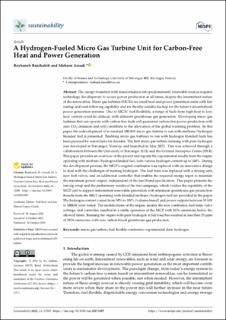| dc.description.abstract | The energy transition with transformation into predominantly renewable sources requires technology development to secure power production at all times, despite the intermittent nature of the renewables. Micro gas turbines (MGTs) are small heat and power generation units with fast startup and load-following capability and are thereby suitable backup for the future’s decentralized power generation systems. Due to MGTs’ fuel flexibility, a range of fuels from high-heat to low-heat content could be utilized, with different greenhouse gas generation. Developing micro gas turbines that can operate with carbon-free fuels will guarantee carbon-free power production with zero CO2 emission and will contribute to the alleviation of the global warming problem. In this paper, the redevelopment of a standard 100-kW micro gas turbine to run with methane/hydrogen blended fuel is presented. Enabling micro gas turbines to run with hydrogen blended fuels has been pursued by researchers for decades. The first micro gas turbine running with pure hydrogen was developed in Stavanger, Norway, and launched in May 2022. This was achieved through a collaboration between the University of Stavanger (UiS) and the German Aerospace Centre (DLR). This paper provides an overview of the project and reports the experimental results from the engine operating with methane/hydrogen blended fuel, with various hydrogen content up to 100%. During the development process, the MGT’s original combustor was replaced with an innovative design to deal with the challenges of burning hydrogen. The fuel train was replaced with a mixing unit, new fuel valves, and an additional controller that enables the required energy input to maintain the maximum power output, independent of the fuel blend specification. This paper presents the test rig setup and the preliminary results of the test campaign, which verifies the capability of the MGT unit to support intermittent renewable generation with minimum greenhouse gas production. Results from the MGT operating with blended methane/hydrogen fuel are provided in the paper. The hydrogen content varied from 50% to 100% (volume-based) and power outputs between 35kW to 100kW were tested. The modifications of the engine, mainly the new combustor, fuel train, valve settings, and controller, resulted in a stable operation of the MGT with NOx emissions below the allowed limits. Running the engine with pure hydrogen at full load has resulted in less than 25 ppm of NOx emissions, with zero carbon-based greenhouse gas production. | en_US |

